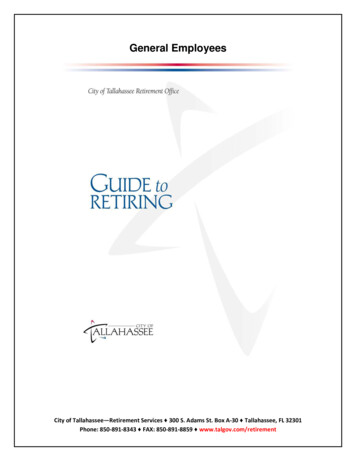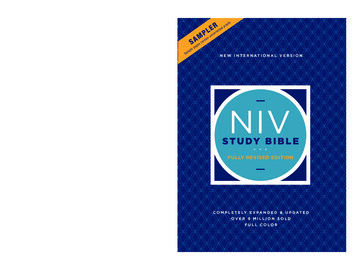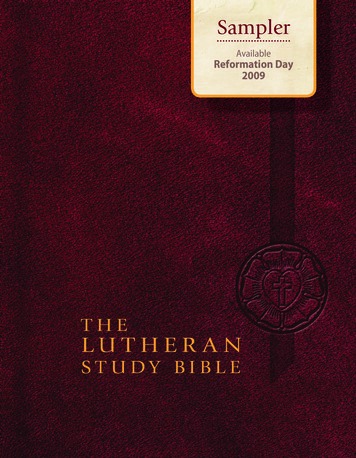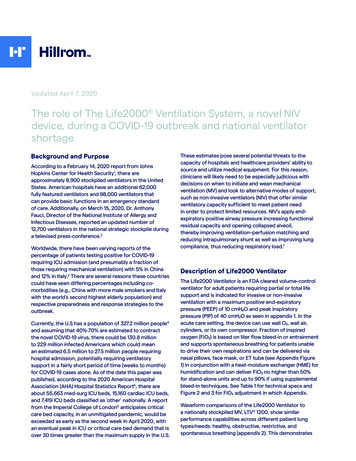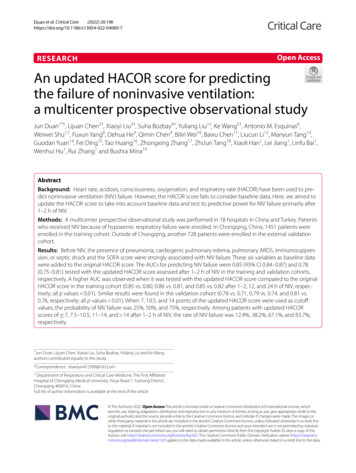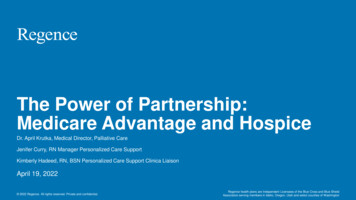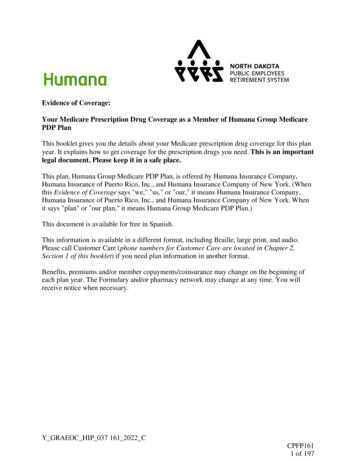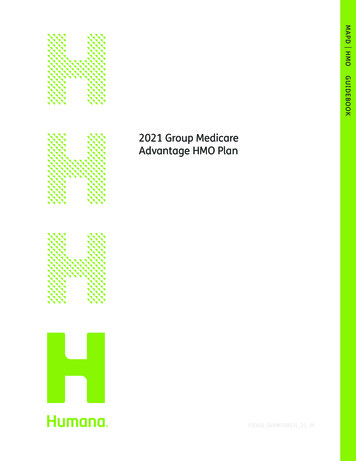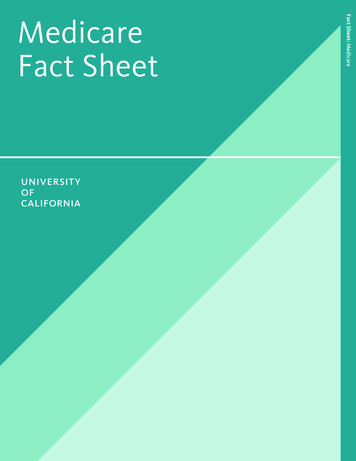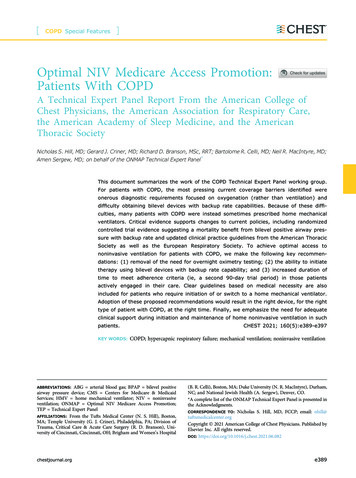
Transcription
[COPD Special Features]Optimal NIV Medicare Access Promotion:Patients With COPDA Technical Expert Panel Report From the American College ofChest Physicians, the American Association for Respiratory Care,the American Academy of Sleep Medicine, and the AmericanThoracic SocietyNicholas S. Hill, MD; Gerard J. Criner, MD; Richard D. Branson, MSc, RRT; Bartolome R. Celli, MD; Neil R. MacIntyre, MD;Amen Sergew, MD; on behalf of the ONMAP Technical Expert Panel*This document summarizes the work of the COPD Technical Expert Panel working group.For patients with COPD, the most pressing current coverage barriers identified wereonerous diagnostic requirements focused on oxygenation (rather than ventilation) anddifficulty obtaining bilevel devices with backup rate capabilities. Because of these difficulties, many patients with COPD were instead sometimes prescribed home mechanicalventilators. Critical evidence supports changes to current policies, including randomizedcontrolled trial evidence suggesting a mortality benefit from bilevel positive airway pressure with backup rate and updated clinical practice guidelines from the American ThoracicSociety as well as the European Respiratory Society. To achieve optimal access tononinvasive ventilation for patients with COPD, we make the following key recommendations: (1) removal of the need for overnight oximetry testing; (2) the ability to initiatetherapy using bilevel devices with backup rate capability; and (3) increased duration oftime to meet adherence criteria (ie, a second 90-day trial period) in those patientsactively engaged in their care. Clear guidelines based on medical necessity are alsoincluded for patients who require initiation of or switch to a home mechanical ventilator.Adoption of these proposed recommendations would result in the right device, for the righttype of patient with COPD, at the right time. Finally, we emphasize the need for adequateclinical support during initiation and maintenance of home noninvasive ventilation in suchCHEST 2021; 160(5):e389-e397patients.KEY WORDS:COPD; hypercapnic respiratory failure; mechanical ventilation; noninvasive ventilationABBREVIATIONS:(B. R. Celli), Boston, MA; Duke University (N. R. MacIntyre), Durham,NC; and National Jewish Health (A. Sergew), Denver, CO.*A complete list of the ONMAP Technical Expert Panel is presented inthe Acknowledgments.CORRESPONDENCE TO: Nicholas S. Hill, MD, FCCP; email: nhill@tuftsmedicalcenter.orgCopyright Ó 2021 American College of Chest Physicians. Published byElsevier Inc. All rights reserved.DOI: urnal.orge389ABG arterial blood gas; BPAP bilevel positiveairway pressure device; CMS Centers for Medicare & MedicaidServices; HMV home mechanical ventilator; NIV noninvasiveventilation; ONMAP Optimal NIV Medicare Access Promotion;TEP Technical Expert PanelAFFILIATIONS: From the Tufts Medical Center (N. S. Hill), Boston,MA; Temple University (G. J. Criner), Philadelphia, PA; Division ofTrauma, Critical Care & Acute Care Surgery (R. D. Branson), University of Cincinnati, Cincinnati, OH; Brigham and Women’s Hospital
Note to the Reader: The current document is one of aseries produced by a Technical Expert Panel (TEP), whosepurpose was to propose changes to Centers for Medicare& Medicaid Services national coverage determinations forthe use of noninvasive ventilation and home mechanicalventilation, which were formulated in 1998. Specifically,the TEP proposed changes to national coveragedeterminations for thoracic restrictive disorders(neuromuscular disease), COPD, hypoventilationsyndromes, central sleep apnea, and OSA. Thebackground, makeup of the TEP, and keyrecommendations are highlighted in an ExecutiveSummary. CHEST, the American Association forRespiratory Care, the American Academy of SleepMedicine, and the American Thoracic Society formed the“Optimal NIV Medicare Access Promotion (ONMAP)” toprovide processes to obtain the “right device for the rightpatient at the right time.” More details and rationale forthe proposed changes are available in the companiondocuments.BackgroundThere are an estimated 24 million people with COPD inthe United Sates. COPD is the third or fourth leadingcause of death,1,2 and the cost of caring for patients withCOPD in the United States was calculated at 49 billiondollars in 2020 html). COPD leads to deterioration of lungfunction over decades, and when obstruction becomessevere (FEV1 50%), it is often accompanied by gasmismatch andQexchange abnormalities, including V/increased dead space, which impair the ability tomaintain normal oxygenation and alveolar ventilation.3Once hypoxemia during wakefulness reaches criticallevels (PaO2 55 mm Hg), supplemental oxygenimproves survival.4 Impairment of alveolar ventilationpredisposes to progressive hypercapnia as compensatorymechanisms fail, initially during sleep but eventuallybecoming diurnal.5 In these cases, a rise in PaCO2 abovethe normal threshold of 45 mm Hg is independentlyassociated with increased mortality.6 Studies haveshown that use of noninvasive positive pressureventilatory support via a mask to lower PaCO2 in thesepatients lowers mortality and reduceshospitalizations.7,8The Problem: Patients Not Receiving AppropriateDevices: In August 2003, the reimbursement ruling waschanged to ensure that all BPAPs, even when used as aventilator with a backup rate, were nevertheless paid as acapped rental item; that is, payments stop after13 months, and the device becomes the property of thepatient. This ruling clarified the reimbursement policyfor BPAPs vs home mechanical ventilators (HMVs),which are defined as devices that need frequent andsubstantial servicing, and discontinuation would lead toimminent death of the patient.This review summarizes the status of Centers forMedicare & Medicaid Services (CMS) coverage policiesfor use of noninvasive ventilation (NIV) for COPD,highlighting the problems with the policies that createbarriers to NIV use and that encourage its inappropriateapplications. We provide recommendations forsolutions to these problems.e390 Special FeaturesCurrent Coverage GuidelinesFor patients with severe COPD, current coverage criterianeed to be satisfied (Local Coverage Determination:Respiratory Assist Devices [L33800; ails/lcd-details.aspx?LCDId¼33800]). These criteria qualify a patientfor a respiratory assist device, or “RAD,” without abackup rate (ie, a bilevel positive airway pressure device[BPAP] in the spontaneous mode that requires thepatient to initiate all breaths spontaneously). The RADterminology was a creation of CMS and exists nowhereelse in the clinical literature, and it needs to beeliminated in the future. A BPAP with a backup rate(spontaneous/timed mode) would be covered if, after2 months, the patient was using the device for 4 h of24 h, symptoms persisted, PaCO2 remained 52 mm Hg orabove, AND overnight oxygen saturation was # 88% for 5 min on the usual FIO2.Some 17 years later, technological advances have led tooverlap of the two categories of devices (BPAPs andHMVs) used to treat patients with chronic hypercapnicrespiratory failure. HMVs have internal batteries, moresophisticated monitoring and alarms, and greaterpressure-generating capabilities than BPAPs, but bothdevices can provide BPAP settings as well as volumetargeted modes. In the past, the ability to providevolume-targeted modes distinguished ventilators fromBPAPs, but with the advent of modes such as volumeassured pressure support, this distinction is now blurred.It is now more difficult to tie device reimbursement tomedically necessary treatment plans chosen for onepatient or another when BPAP settings are deliverablewith either a BPAP or an HMV. Moreover, the currentqualification criteria for using a BPAP device may creategreater barriers to approval than with an HMV (seebelow). This factor, in combination with the fact thatHMVs are reimbursed by CMS at higher rates than[160#5 CHEST NOVEMBER 2021]
BPAPs and without a cap, has led to a large increase inthe utilization of HMVs and a huge rise in expendituresin the COPD population over the past 5 years, asdiscussed in the Executive Summary.As outlined here, the problems with the current nationalcoverage determination for NIV in COPD can best bedescribed by using case vignettes illustrating the barriersthe current criteria can pose as clinicians struggle toprovide the appropriate device.1. Overnight oxygen saturation # 88% for 5 min, witha minimum of 2 h of nocturnal recording on 2 L/min ofsupplemental oxygen or the patient’s prescribed level,whichever is higher.Vignette: J. M. is a 64-year-old woman who has severeCOPD and chronic hypercapnic respiratory failurerequiring 2 L/min continuous oxygen therapy. Duringher usual chronic stable state, arterial blood gas (ABG) ischecked, and the PaCO2 is 52 mm Hg. A nocturnaloxygen assessment is ordered while she uses her usual 2L/min of oxygen via nasal prongs and shows no oxygensaturations # 88% for 5 min. She is told she does notqualify for NIV and wonders if there are any othertherapies for her that could improve her quality andlength of life.This criterion is not physiologically sound. Use ofoxygen supplementation during sleep is likely to maskCO2 elevations, leading to nocturnal normoxia despitemoderate or even severe nocturnal hypercapnia. Onestudy of patients with COPD and a resting PaCO2 52 mm Hg (mean PaCO2 of 61.5 mm Hg) had persistent110Percentage/mm Hg100908070605040302002468Study HourPvCO2SpO21012EtCO2Figure 1 – Severe nocturnal hypercapnia despite normoxia in hospitalized patients with COPD receiving supplemental nasal oxygen at 2 L/min. EtCO2 ¼ end-tidal CO2; SpO2 ¼ oxygen saturation by pulse oximetry; PvCO2 ¼ venous PCO2.chestjournal.orghypercapnia with a median partial pressure of CO2 invenous blood of 69.5 mm Hg and end-tidal CO2 of41.5 mm Hg despite normal blood oxygen saturation(Fig 1).9 None of the patients had desaturations 90% despite their persistent hypercapnia. Furthermore,no studies on use of NIV for severe stable COPD orfollowing a severe exacerbation have used this criterionfor inclusion, and there is a complete lack of evidence tosupport it. To deny NIV, which could provide thebenefits the patient is seeking, based on a lack ofnocturnal oxygen desaturations while on supplementaloxygen is problematic and without any scientificjustification. This either prevents patients from receivingpotentially beneficial therapy or forces prescribers to askfor ventilators that offer more technology and are morecostly. The nocturnal oximetry requirement must beremoved.2. When should an HMV be considered instead of BPAPtherapy?Vignette: A 65-year-old woman presents with increasedfatigue, shortness of breath, and lower extremity edema.She has had no increased cough or phlegm recently, andno recent hospitalizations. The FEV1 is 24% ofpredicted, and she is on 4 L/min of oxygen via nasalprongs at rest. ABG shows a PaCO2 of 64 mm Hg andserum bicarbonate of 38 mEq/L. The patient is startedon BPAP NIV with inspiratory pressure of 18 cm H20.She reports inspiratory discomfort and air leakage, andaverages 4.5 h of use nightly; the device has no capabilityto better optimize the flow delivery. One month later,the patient is feeling no better and is very fatigued in themorning. Repeat ABG shows a PaCO2 of 62 mm Hg andserum bicarbonate of 37 mEq/L. She is switched to anHMV in volume-assured pressure support modetargeting a tidal volume of 8 mL/kg, inspiratory pressurerange of 28 cm H2O maximum and 12 cm H2Ominimum, and a backup rate of 15 breaths/min. Onthese settings, she sleeps better at night and has moreenergy during the day. An ABG reveals PaCO2 of 50 cmH2O with bicarbonate of 32 mEq/L.HMVs should be considered in patients with persistenthypercapnia above the targeted goals for ventilationdespite BPAP support at therapeutic levels and in thosepatients with significant dyssynchrony with BPAPsupport and those with oxygenation requirements thatcannot be met by BPAP devices. They should also beconsidered in those who require inspiratory positiveairway pressure levels 25 cm H2O (ie, greater thanwhat can be delivered by most E0471 devices) or cane391
A separate clinical issue, not addressed under currentpolicy, is the lack of provision to ensure expert clinicalsupport of a respiratory therapist in the home. This maylead to failure of home ventilatory support and thetransfer of some patients with more complex chronicrespiratory failure to a chronic care facility. This actiondetracts from the patient’s well-being and increases coststo the health care system. The core of the problem isthat the current reimbursement policy forces adisconnect between the patient’s clinical status/needsand reimbursement because payment policies are lockedinto devices rather than the clinical situation.10 This ismore fully addressed in a commentary below.Current Evidence/GuidelinesSince the current coverage criteria were enacted, newcrucial evidence has accrued, and technology hasevolved. It is time to critically re-examine the guidelinesand suggest alterations that will facilitate the delivery ofthe right device to the right patient at the right time.Past studies on the nocturnal home use of BPAP ventilationto treat chronic respiratory failure in COPD providedvariable and often conflicting results.11 In 2014, Kohnleinet al7 published a landmark prospective, multicenter,randomized controlled trial of BPAP ventilation comparedwith optimized standard therapy in patients with chronicstable hypercapnic COPD. Patients had stage IV COPD anda mean age of 64.4 years, with resting PaCO2 51.9 mm Hgand pH 7.35. BPAP ventilation was targeted to reducebaseline PaCO2 by at least 20%, or to achieve values 48 mm Hg, using high inspiratory pressures and a backuprate. The difference in 1-year all-cause mortality wasprofound, with 12% in the BPAP group and 33% in thecontrol group (Fig 2).Secondary improvements were also seen in FEV1, PaCO2,and pH in the BPAP group compared with the controle392 Special FeaturesCumulative Mortalityalso be considered in patients who have an unreliablepower source and would benefit from the backupbatteries. Other patients likely to benefit include thosewith severe hypoxemia requiring FIO2 40% or 5 L/min, those requiring daytime ventilator support (ie, 10 h per day or mouthpiece ventilation), and those whoneed more sophisticated alarms. As with patients withthoracic restrictive disorders, these patients can be mosteasily identified by their high ventilatory needs requiringextended ventilation times into the daytime hours.Moreover, the patient with COPD struggles even morefrom severe gas exchange abnormalities withhypoxemia. Their required therapy is not successfullysatisfied with current BPAP equipment.0.40P .00040.300.200.1000No. at riskControl group 93Intervention group 102300400100200Time (Days After Randomization)7795Control group72926990Intervention groupFigure 2 – Effect of noninvasive ventilation with backup rate vs oxygentherapy alone on survival in stable severe hypercapnic COPD. (FromKohnlein et al.7).group.7 No intervention-related complications werereported except for facial skin rash in 14% of patients.Quality of life also improved. The effect of BPAP onoverall survival in patients with chronic hypercapnicCOPD was believed to be related to the use of a highinspiratory pressure and backup rate (termed highintensity ventilation). The rationale for the backup rateis that it helps to sustain nocturnal ventilation in the faceof physiological suppression of respiratory drive duringsleep, which, combined with diaphragm dysfunctionrelated to hyperinflation, can lead to hypoventilationand failure to trigger, especially during rapid eyemovement sleep.Another approach to initiating BPAP in patients withsevere COPD is to intervene following an admission foracute respiratory failure. This has garnered additionalinterest because of concerns regarding hospitalreadmission rates in patients with COPD. Murphy et al8used this approach, enrolling 116 patients with mean ageof 66.7 years and persisting hypercapnia ( 53 mm Hg),at least 2 weeks following resolution of decompensatedacidosis and within 4 weeks of attaining clinical stabilityfollowing a hospitalization that required use of acuteNIV. Patients were randomized to receive high-pressureNIV (average inspiratory pressure 24 cm H2O,expiratory pressure 4 cm H2O with a backup rate of 14breaths/min) with home oxygen therapy or homeoxygen therapy alone. The primary outcome, hospitaladmission or death, was again significantly different,with home oxygen therapy patients requiringreadmission following a median of 1.4 months’postdischarge compared with 4.3 months for patientsusing BPAP ventilation. One-year mortality was not[160#5 CHEST NOVEMBER 2021]
significantly different between the groups, buttranscutaneous PCO2 and frequency of exacerbationswere reduced and quality of life improved in the BPAPgroup. Another similarly designed study by Struik et al12found no significant differences in readmissions ormortality, although these patients did not manifestpersistent hypercapnia.These data provide important information regarding: (1)the level of resting hypercapnia in patients likely tobenefit from home NIV; (2) the lack of need to performa sleep study or nocturnal oximetry to select patientswith COPD and a BMI 35 kg/m2 for successful NIV;and (3) the importance of using higher inspiratorypressure settings/pressure support level than olderstudies and the addition of backup respiratory breaths toachieve a reduction in PaCO2. Although surrogate PaCO2measurements such as end-tidal or transcutaneousoptions may be appropriate for patients with thoracicrestrictive disorders or other hypoventilationsyndromes, an ABG with a PaCO2 is necessary forpatients with COPD to identify the hypoventilatorythreshold (PaCO2 52 mm Hg) expected to benefit fromNIV, based on the aforementioned literature and expertopinion. Whether surrogate measurements of PaCO2 canbe used for qualifying patients with COPD for homeNIV or for monitoring subsequent responses remains tobe established.The findings from the clinical studies described herehave been substantiated by Frazier et al13 using theMedicare Limited Data Set (2012-2018). They compared517 patients with COPD started on NIV within2 months of receiving a diagnosis of chronic respiratoryfailure vs 511 patients with COPD matched fordemographic and clinical characteristics but who werenot started on NIV. One year following diagnosis,mortality in the NIV group was 28% vs 46% in thecontrol subjects. The relative risk reduction attributableto NIV was 39% for mortality, 17% for hospitalizations,and 22% for ED visits.In 2019, the Agency for Healthcare Research andQuality contracted for a technology assessment of NIVin the home. Based on a systematic review of theliterature, the task force concluded that for COPD,BPAP reduced dyspnea and mortality and increasedactivities of daily living, whereas both BPAP and HMVreduced hospitalizations.14The European Respiratory Society Task Force in201915 and an American Thoracic Societychestjournal.orgsubcommittee in 202016 both suggested using longterm home NIV for stable hypercapnic COPD as wellas for patients with COPD following hospitalizationfor an exacerbation requiring NIV. The AmericanThoracic Society guideline suggested waiting for atleast 2 weeks to assure persistence of hypercapnia(conditional recommendation, very low certainty),whereas the European Respiratory Society suggestedthat reassessment could be considered but was notnecessary and seemed to suggest it should be left upto the discretion of the treating physician. TheTechnical Expert Panel (TEP) agrees with theEuropean Respiratory Society recommendation thatthe timing of intervening with NIV followinghospitalization should be left to the clinician’sdiscretion. Both guidelines also recommendedventilator settings to reduce PaCO2, with the AmericanThoracic Society guideline suggesting to “targetnormalization.” The European Respiratory Societyguideline also suggested “fixed pressure support” asthe preferable mode.Optimal NIV Medicare Access Promotion(ONMAP): New National CoverageDetermination for BPAP Devices in COPD1. Removal of the requirement for a nocturnal oximetrystudy using either 2 L/min nasal oxygen or the patient’s usual FIO2, whichever is higher.2. Removal of the requirement that patients start with aBPAP device without a backup rate.Replace with:For patients with severe COPD, all of the followingcriteria need to be satisfied:1. ABG while awake and receiving supplemental oxygen(if prescribed) displaying a PaCO2 52 mm Hg.2. OSA and CPAP treatment have been considered andruled out (formal testing not required; this only requires clinical documentation).3. Patients with severe hypercapnic COPD should beconsidered for an HMV under the following circumstances if they need any of the following: Higher inspiratory pressures than those deliverableby E0471 FIO2 higher than 40% or 5 L/min nasally Ventilator support for 10 h per day or greater(ie, daytime use) Both sophisticated alarms and accompanying internal battery (high-dependency patient)e393
Mouthpiece ventilation during the day Persistence of hypercapnia with PaCO2 52 mm Hg despite adequate adherence toBPAP therapyAdherence and Monitoring of NIV in COPDInitiationInitiation of long-term NIV may occur in the hospitalsetting, usually following use of NIV acutely for anexacerbation, or at home in a patient with stable chronichypercapnia. Whether in-hospital initiation of NIV, as isfavored in Europe, is preferable to home initiation, as isfavored in the United States, has not been firmlyestablished. A randomized controlled trial from TheNetherlands showed noninferiority of home initiationcompared with in-hospital initiation of NIV for severestable COPD.17 Reduction in PaCO2 over 6 months, themajor outcome variable, was similar in the two groups,overall costs were halved in the home group, andpatients preferred initiation in the home. The homegroup was contacted frequently by trained nurses, andtelemedicine was used to monitor patients in the home.Over the past two decades, the hardware and software ofhome ventilators have undergone major technicaladvances. In addition to pressure support and BPAPspontaneous/timed modes, volume-assured pressuresupport, autotitrating expiratory positive airwaypressure, and built-in algorithms profiled for certainpathologies are now standard options on manyventilators. More importantly, built-in software providesimportant information for monitoring the efficacy ofNIV (ie, estimation of leaks, tidal volume, percentage ofcycles triggered and cycled by the ventilator, adherence).This allows a better capacity to facilitate, monitor, andassess the benefits of the therapy.18AdherenceSome studies have reported lower adherence to NIV inpatients with COPD compared with those withneuromuscular disease19 and others show similar ratesof adherence, with 30% using the device 4 h per dayand 13% abandoning the therapy altogether within28 months.20 The importance of adherence ishighlighted by a study of 1,746 patients on NIV forhypercapnic respiratory failure followed up over 6 years,of whom 20% had obstructive lung disease. The singlemost important factor associated with a poor outcomewas low adherence (NIV use 4 h per day).21 For thise394 Special Featuresreason, we recommend adaptation of adherence criteriaas proposed in the other TEP reports, including thesecond 90-day trial period for those patients not meetinginitial adherence criteria for continued coverage whoreturn at least twice to a treating physician and seebenefit from continued use. Rehospitalization wouldconstitute criteria for a new HMV initiation trial even inthose previously failing to meet adherence criteria.MonitoringOverall, the recommendations for follow-up of patientswith COPD using NIV in the home include thefollowing elements: (1) clinical assessment byexperienced personnel familiar with the consequences ofCOPD and NIV use; (2) ABG PaCO2 for response andaid to ventilator adjustment guidance to meet theevolving needs of the patient; (3) nocturnal pulseoximetry as a dynamic complement (for monitoringonly, not initiation) to the ABG; and (4) trend report,including patterns of use, synchrony and triggeredbreaths, respiratory rate and tidal volume, minutevolume, and leaks from ventilator software, which isnow available in most modern devices.Need for Clinical Support of Patients WithCOPD Using NIVWe fully recognize that the Medicare durable medicalequipment benefit does not provide clinical support forNIV equipment in the home as a separately billableservice. However, it is clear to the medical communitythat such services are essential for safe and effectivedelivery of NIV. Without such support, patients are athigh risk for ineffective device performance that willcompromise clinical efficacy and ultimately lead toexcessive patient morbidity and even mortality. This isespecially important given the fact that durable medicalequipment quality standards require a respiratorytherapist to be available 24/7 with respect to the use ofrespiratory equipment. Numerous states also requirequalified clinicians (eg ,respiratory therpists) to performclinical assessments in addition to placing any patient onthe device when engaged in the initial set-up andeducation of the patient and/or caregiver regarding theequipment.As an example, a review of the experience of long-termhome NIV in the Lake Geneva area of Switzerlandenrolled 479 patients over 15 years and followed up withthem for a median of 39 months.22 COPD constitutedthe largest individual group (28%); overall, 82% were[160#5 CHEST NOVEMBER 2021]
Severe COPD ABG while awake breathing usual FIO2 demonstratesPaCO2 t 52 mm Hg OSA has been considered and excluded (formalsleep testing not required)Start BPAP with backup rate or HMV if criteria met in panel below right Adherent to therapy ( 4 h per day) Clinician evaluation day 31-90 after initiationVentilation goals achieved?No Daytime use Inspiratory pressure higher thanthose deliverable by E0471 Need for FIO2 40% Need for mouthpiece ventilation Need for battery backup/advancedalarm requirementYes Continue BPAP Initiate HMVFigure 3 – Suggested management of patients with COPD who require noninvasive ventilation. ABG ¼ arterial blood gas; BPAP ¼ bilevel positiveairway pressure; HMV ¼ home mechanical ventilator.initiated on NIV in the hospital and the rest in theoutpatient setting. Comorbidities were very common inthe patients with COPD; 68% had hypertension,46% were obese, and 21% had probable pulmonaryhypertension. In that cohort, adherence was excellent;only 8% of patients used NIV 3 h per day, likelybecause of excellent patient follow-up, either hospitalbased or by an outpatient pulmonologist. Thus, toachieve optimal adherence, clinical resources will needto be available for these medically complex patients.Our specific comments are as follows:1. Initial NIV set-up. To provide effective respiratorysupport, NIV devices must interact with patientbreathing efforts throughout the ventilatory cycle.Specifically, the patient must exert enough effort toinitiate a breath and must synchronize with the deviceto assure adequate pressure and flow deliverythroughout the breath. Patients with COPD haveseverely deranged lung mechanics leading to pronounced dyspnea and anxiety. This can make the NIVset-up process very complex, often requiring multipleadjustments and assessment of responses. Initial NIVset-up in such complex patients cannot be accomplished during short outpatient clinic visits andcertainly not by use of prerecorded/printed materialchestjournal.orgalone.17 We advocate for the provision of frequentvisits to the patient’s home by skilled qualified clinicians (eg respiratory therpists) who can then make thenecessary adjustments to optimize the likelihood ofsuccess.2. Ongoing NIV use. The natural history of COPD isprogressive functional deterioration punctuated byexacerbations. This means that NIV support is notstatic and must be capable of adapting to changingpatient conditions and other medical interventions(eg, change in respiratory medications, use of supplemental oxygen). Patients cannot be expected tomake these adjustments on their own. Moreover,although physicians (or their assistants) in outpatientsettings may occasionally be able to troubleshoot orreset devices via telephone or telemedicine, these tasksare more reliably performed via home face-to-facevisits in which both the ventilator and patient can beobserved directly. Dedicated qualified clinicians (egrespiratory therapists) who are experts in NIV operations are needed both on 24-h hot lines as well asbeing readily accessible for in-home visits.3. A strong evidence base supports the necessity ofongoing clinical/technical support for these patients.The 2020 Agency for Healthcare Research andQuality evidence-based review identified 36 studiese395
showing benefit of NIV in patients with hypercapnicCOPD. These studies extended up to 48 months, andall of them had ongoing clinical/technical support ofsome form for the duration of the trial.14 This is also acommon clinical practice and the standard of care inmost European NIV programs. In the United States,respiratory therapy services in the home are notreimbursed, making it difficult to provide these services, especially for patients on NIV via BPAP.4. The COPD TEP concluded that the expertise ofexperienced clinicians (eg, respiratory therapists) toprovide the needed support for individuals on homeNIV is critical to patient care and avoidance of risk tothe patient, whether patients are using BPAP orHMV. We would strongly urge CMS to work with themedical community to find ways to pro
NIV (ie, estimation of leaks, tidal volume, percentage of cycles triggered and cycled by the ventilator, adherence). This allows a better capacity to facilitate, monitor, and assess the benefits of the therapy.18 Adherence Some studies have reported lower adherence to NIV in patients with COPD compared with those with
